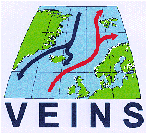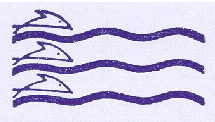

Departure: Ólafsvík, Iceland, August 12th 1997
Arrival: Reykjavík, Iceland, September 5th 1997
Sveinn Sveinbjörnsson, Chief Scientist, 0-group
Héðinn Valdimarsson, Physical Oceanography, Argos drifters
John Mortensen, Physical Oceanography, Argos drifters
Albert Stefánsson, Physical Oceanography, 0-group
Björn Sigurðarsson, Physical Oceanography, 0-group
Sigurður Jónsson, Physical Oceanography, 0-group
Gísli Ólafsson, 0-group
Páll Svavarsson, 0-group
Sigurður Gunnarsson, 0-group
The A14-97 cruise was carried out by the Marine Research Institute (MRI) on the RV Árni Friðriksson with the following aims:
The RV Árni Friðriksson left Ólafsvik harbor, Snæfellsnes at 2000 hour on the 12th of August 1997 for the A14-97 cruise.
The vessel headed for the Denmark Strait NW of Iceland (Látrabjarg and Kögur sections) from the Icelandic coast to the ice-limit and eastwards into North Icelandic waters (Húnaflói, Siglunes, Langanes NE) and from East Icelandic waters ( Langanes E and Krossanes sections) to south Icelandic waters (Stokksnes, Ingólfhöfði and Selvogsbanki sections). The RV arrived to Reykjavik at 1430 hour on the 5th of September.
Sections confined to VEINS are those of Látrabjarg, Kögur, Langanes NE and Krossanes. Locations of sections and where surface drifters were deployed are shown in Figure 1.
The hydrographic work was carried out with a CTD-water sampling units equipped with Seabird Inc. SBE 911plus CTD. The unit, a MRI made rosette equipped with modified Hydro-Bios 1.7 liter water bottles, was used on all CTD stations. A Sea-Tec transmissometer was attached to the unit. The CTD was equipped with newly calibrated temperature and conductivity sensors and water samples were collected at deepest sampling level on all stations for calibration purposes.
Temp. Calibr. Cond. Calibr. sensor date sensor date Unit A 943 07-06-97 498 06-06-97
All the goals of the cruise were achieved (see list of CTD stations and cruise track ) except a section west of Iceland (Faxaflói) and 3 planned deployments of SVP-drifters had to be post-phoned to the next MRI cruise due to weather conditions and changed cruise plans. The Faxaflói section was fulfilled in September (see cruise B10-97) as well as the drifter deployments.
The main results of the hydrographic observations in Icelandic waters in August 1997 were the following: South and west of Iceland salinities and temperatures were relatively high (7-10°C) with a strong warming up in the surface layers. The Atlantic inflow (Irminger Current) into North Icelandic waters was also quite pronounced (5-6°C; S>35.0), covered by a low saline surface layer. A slight relative cold (4°C) intrusion from the north was observed in the western part of the area. Off the East coast of Iceland temperatures were also relatively high (>4°C). In deeper waters northeast and east of Iceland the cold East Icelandic Current was, on the other hand, pronounced as earlier this year (0-2°C) but with a strong warming up in the surface layer (7-8°).
It is concluded that in the summer of 1997 temperatures were relatively high in the survey area with strong warming up in the surface layers in general.
As a support to the above findings are preliminary TS-diagrams from the
Látrabjarg, Kögur, Langanes NE and Krossanes sections shown. In
addition are preliminary potential temperature and salinity sections shown for
Látrabjarg (Fig. 3a and Fig. 3b),
Kögur (Fig. 4a and Fig. 4b),
Langanes NE (Fig. 5a and Fig. 5b) and
Krossanes (Fig. 6a and Fig. 6b)
sections respectively, which all are part of the VEINS programme.
List of CTD Stations
St.no Date UTC Lat. Lon. Depth S 446 130897 1146 65 30.10 N 24 34.10 W 34 x 448 130897 1312 65 35.01 N 24 55.17 W 63 x 450 130897 1437 65 40.03 N 25 16.03 W 84 x 452 130897 1603 65 45.00 N 25 38.00 W 269 x 453 130897 1707 65 50.04 N 26 00.03 W 217 x 455 130897 1850 65 53.99 N 26 29.15 W 266 x 457 130897 2040 66 01.50 N 26 47.03 W 440 x 458 130897 2144 66 05.01 N 27 03.10 W 655 x 460 130897 2307 66 09.00 N 27 15.30 W 518 x 467 140897 1208 65 50.90 N 30 00.20 W 358 x 507 170897 2148 67 35.12 N 23 55.76 W 979 x 509 180897 0019 67 20.04 N 23 40.21 W 509 x 510 180897 0208 67 05.06 N 23 28.10 W 231 x 514 180897 0458 66 53.03 N 23 19.46 W 226 x 515 180897 0627 66 40.54 N 23 08.34 W 72 x 517 180897 0800 66 30.34 N 23 00.03 W 55 x 546 200897 0937 66 29.98 N 20 46.95 W 192 x 548 200897 1158 66 44.90 N 20 46.03 W 329 x 551 200897 1529 66 59.98 N 20 47.34 W 200 x 556 200897 2051 67 29.88 N 20 47.74 W 384 x 558 210897 0056 67 59.92 N 20 47.98 W 960 x 576 230897 1436 65 50.93 N 18 08.36 W 73 x 580 230897 2015 66 16.00 N 18 48.00 W 80 x 582 230897 2206 66 24.00 N 18 50.00 W 420 x 584 230897 2346 66 32.00 N 18 50.00 W 460 x 586 240897 0211 66 43.94 N 18 49.96 W 683 x 589 240897 0640 67 00.03 N 18 49.79 W 203 x 592 240897 1217 67 20.07 N 18 50.09 W 476 x 594 240897 1543 67 39.99 N 18 49.90 W 405 x 597 240897 1921 67 59.99 N 18 49.79 W 1020 x 622 260897 1214 67 30.07 N 16 15.02 W 805 x 624 260897 1500 67 09.97 N 16 15.06 W 378 x 627 260897 1824 66 50.12 N 16 14.74 W 246 x 641 270897 1650 68 00.06 N 12 40.76 W 1846 x 643 270897 2006 67 45.09 N 12 58.40 W 1825 x 644 270897 2230 67 29.94 N 13 14.46 W 1725 x 645 280897 0128 67 14.97 N 13 33.64 W 1539 x 648 280897 0506 67 00.00 N 13 50.20 W 365 x 651 280897 0856 66 36.94 N 14 15.71 W 180 x 658 280897 2231 66 22.06 N 09 59.72 W 1279 x 660 290897 0142 66 22.01 N 10 59.84 W 1370 x 663 290897 0549 66 22.00 N 12 04.95 W 1085 x 666 290897 0941 66 21.98 N 12 59.91 W 156 x 668 290897 1144 66 22.18 N 13 34.19 W 268 x 671 290897 1431 66 21.94 N 14 00.91 W 148 x 672 290897 1528 66 21.99 N 14 22.09 W 61 x 688 310897 1347 65 00.00 N 13 30.18 W 57 x 691 310897 1631 65 00.00 N 12 49.05 W 114 x 694 310897 1959 65 00.13 N 11 40.14 W 221 x 696 310897 2128 65 00.72 N 11 17.09 W 536 x 698 010997 0106 64 59.96 N 10 07.05 W 594 x 700 010997 0431 64 59.82 N 09 01.07 W 1335 x 710 010997 2258 63 40.11 N 13 39.59 W 1149 x 711 020997 0050 63 48.07 N 13 57.82 W 269 x 712 020997 0140 63 51.94 N 14 07.99 W 203 x 714 020997 0342 64 02.00 N 14 27.99 W 133 x 717 020997 0603 64 11.99 N 14 50.06 W 76 x 720 020997 1149 63 45.96 N 16 36.20 W 68 x 722 020997 1301 63 41.93 N 16 29.90 W 86 x 723 020997 1405 63 33.97 N 16 17.96 W 108 x 726 020997 1854 63 00.00 N 15 25.00 W 1759 x 729 030997 0040 62 44.87 N 17 14.96 W 1732 x 734 030997 1144 62 45.05 N 19 29.90 W 1565 x 739 030997 1915 63 41.08 N 20 41.14 W 47 x 741 030997 2056 63 29.09 N 20 53.74 W 86 x 742 030997 2210 63 18.94 N 21 06.71 W 143 x 744 030997 2344 63 09.05 N 21 18.28 W 476 x 746 040997 0136 62 59.96 N 21 27.99 W 966 x 748 040997 0705 62 45.20 N 22 59.64 W 1146 x 759 050997 0400 64 20.05 N 25 00.04 W 221 x 761 050997 0655 64 20.00 N 24 20.13 W 212 x
| © MRI | Back to Cruise Reports | ||
|
|
|||
| Responsible: John Mortensen | MRI | ||